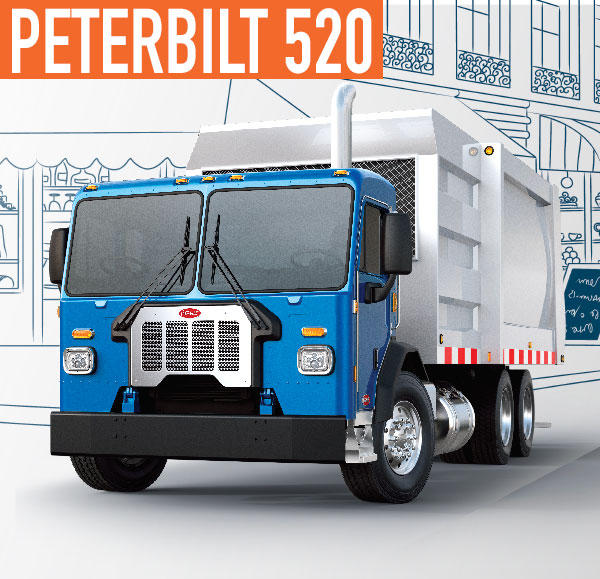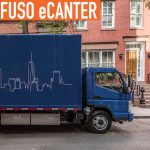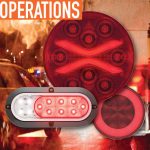There’s nothing more demanding in the vocational work truck arena than the harsh demands of the refuse industry. Built to handle the daily grind is Peterbilt’s Model 520. The rugged, aluminum cab delivers best-in-class durability for increased uptime and lap seam construction on a zinc-coated steel sub-frame for corrosion resistance. Bulkhead-style doors provide years of watertight performance.
POWERTRAIN OPTIMIZATION
The Model 520 diesel engine lineup spans from the lightweight, fuel-efficient PACCAR MX-11, available with up to 430 horsepower and 1,650 lb-ft of torque, to the Cummins ISX12 with ratings up to 400 horsepower and 1,650 lb-ft of torque. The PACCAR PX-9 engine provides one of the highest power-to-weight ratios in its class with up to 380 horsepower and 1,250 lb-ft of torque. For natural gas applications, the Model 520 is available with a choice of 9- or 12-liter engines, including the ISL-G Near Zero Emissions engine. These spark-ignited engines are capable of running on either Compressed Natural Gas (CNG) or Liquefied Natural Gas (LNG). With the flexibility to mount tanks either on the rail or integrated into the body, the Model 520 allows for maximum use of space when integrating a body for a variety of applications.
APPLICATION-READY OPTIONS
This low-cab forward vehicle adds a new dimension of productivity and versatility. The 65-degree cab tilt enhances maintenance and serviceability. Body installation is cost-effective and efficient, and the center console provides convenient access to body control integration points.
The Model 520 features an innovative cab that delivers versatility, comfort, and ergonomics. Center console sides are now angled, providing operators easy visibility and access to controls from either side. An enhanced HVAC system improves airflow and climate control for a more comfortable cab. The Model 520’s interior features an ergonomic dash design with LED-backlit gauges, a driver information display for critical vehicle data, and rocker switches within easy reach for maximum driver comfort and productivity. A 90-degree door opening with three grab handles on each side, and an impact-resistant, bolt-on step provides easy entry and exit.
SEEING IS BELIEVING
According to Peterbilt, the distinguished grille styling accommodates new pantograph wipers, providing 27% more coverage than traditional wipers for improved visibility. Two headlight technologies are available for the Model 520: halogen bulb lamps and optional LED lamps. Both provide excellent brightness and coverage.
NEW CAB CONFIGURATIONS
In May, Peterbilt introduced three new cab configurations for the durable Model 520. The vocational model is now available in Left-Hand Drive, Right-Hand Drive, and Right-Hand Stand-Up Drive, in addition to the existing Dual Seated Drive configuration.
Peterbilt introduced the Model 520 in the Dual Seated Drive configuration in 2016 providing drivers the ability to operate the vehicle from either the left or right position to optimize ergonomics, efficiency, and safety.
The Left-Hand Drive and Right-Hand Drive configurations provide a comfortable seated driving position while in transit or performing curbside operations.
The redesigned Right-Hand Stand-Up cab configuration provides ease of ingress/egress for those applications that require the driver to exit the cab multiple times during the route reducing driver fatigue. Driver ergonomics are further enhanced by standard adjustable seat, angled steering wheel, and dead-pedal to rest their left foot during operation.
“The Model 520 provides superior performance and adaptability in rugged operating environments,” says Robert Woodall, assistant general manager of sales and marketing. “Offering a full lineup of cab configurations for the refuse market further enhances the versatility of this vocational vehicle for our customers’ operations.”
The Model 520 is available with a wide range of engines, including the PACCAR PX-9, PACCAR MX-11, and Cummins ISX12 diesel engines, as well as the Cummins ISL-G, ISL-G Near Zero, and ISX12-G natural gas engines.
FOR MORE INFORMATION
Peterbilt Motors Company—a PACCAR company—combines a global reputation for industry leading design, innovative engineering, and fuel efficiency solutions. Peterbilt also provides a comprehensive array of aftermarket support programs to complement its full lineup of on-highway, vocational, and medium-duty products, including alternative fuel vehicles. Find out more about Peterbilt, visit www.peterbilt.com.
_______________________________________________________________________
MODERN WORKTRUCK SOLUTIONS: DECEMBER 2017 ISSUE
Did you enjoy this article?
Subscribe to the FREE Digital Edition of Modern WorkTruck Solutions magazine.
![]()




